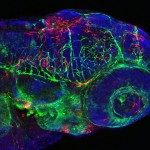Lien vers Pubmed [PMID] – 9683542
Exp. Cell Res. 1998 Aug;242(2):561-72
We are studying defects in glycosphingolipid synthesis in cells lacking vimentin intermediate filaments (vimentin-). Sugars can be incorporated into glycolipids whose ceramide is synthesized either de novo (pathway 1) or from sphingoid bases salvaged from hydrolysis of sphingolipids (pathway 2) and into glycolipids recycling from the endosomal pathway through the Golgi (pathway 3). Vimentin- embryonic fibroblasts, obtained from vimentin-knockout mice, incorporate less sugar into glycolipids than vimentin+ fibroblasts. Using two inhibitors of ceramide synthesis, beta-chloroalanine and fumonisin B1, we found the major defect in synthesis to be in pathway 2 and not in de novo synthesis. We used two additional approaches to analyze the functions of pathways 2 and 3. First, we used exogenous glucosylthioceramide ([14C]C8-Glc-S-Cer), a synthetic, nonhydrolyzable glycosphingolipid, as a precursor for synthesis of larger glycolipids. Vimentin- SW13 cells and embryonic fibroblasts glycosylated [14C]C8-Glc-S-Cer less extensively than their vimentin+ counterparts. Second, we used chloroquine to inhibit the hydrolysis of sphingolipids in endosomes and lysosomes. Chloroquine markedly decreased the incorporation of sugars into glycolipids larger than glucosylceramide. The defect in glycolipid synthesis in vimentin- cells probably results from impaired intracellular transport of glycolipids and sphingoid bases between the endosomal/lysosomal pathway and the Golgi apparatus and endoplasmic reticulum. Intermediate filaments may accomplish this function by contributing to the organization of subcellular organelles and/or by binding proteins that participate in transport processes.

